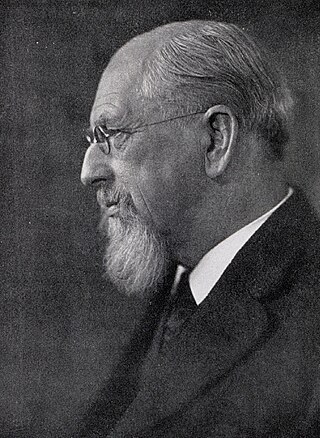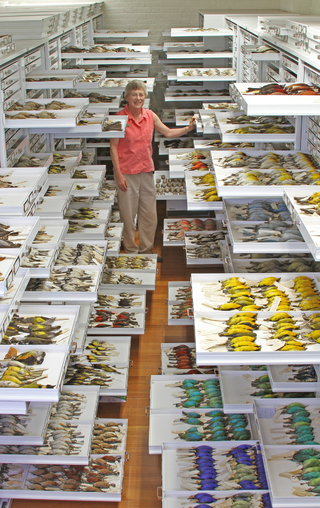
Alexander Emmanuel Rodolphe Agassiz, son of Louis Agassiz and stepson of Elizabeth Cabot Agassiz, was an American scientist and engineer.

Jean Louis Rodolphe Agassiz FRS (For) FRSE was a Swiss-born American biologist and geologist who is recognized as a scholar of Earth's natural history.

The French National Museum of Natural History, known in French as the Muséum national d'histoire naturelle, is the national natural history museum of France and a grand établissement of higher education part of Sorbonne Universities. The main museum, with four galleries, is located in Paris, France, within the Jardin des Plantes on the left bank of the River Seine. It was formally founded in 1793, during the French Revolution, but was begun even earlier in 1635 as the royal garden of medicinal plants. The museum now has 14 sites throughout France.

William Healey Dall was an American naturalist, a prominent malacologist, and one of the earliest scientific explorers of interior Alaska. He described many mollusks of the Pacific Northwest of North America, and was for many years America's preeminent authority on living and fossil mollusks.

Edward Sylvester Morse was an American zoologist, archaeologist, and orientalist. He is considered the "Father of Japanese archaeology."

Addison Emery Verrill was an American invertebrate zoologist, museum curator and university professor.

Thomas Barbour was an American herpetologist. He was the first president of the Dexter School in 1926. From 1927 until 1946, he was director of the Harvard Museum of Comparative Zoology (MCZ) founded in 1859 by Louis Agassiz at Harvard University in Cambridge, Massachusetts.

Charles Frederick Hartt was a Canadian-American geologist, paleontologist and naturalist who specialized in the geology of Brazil.
The Natural History Museum of Utah (NHMU) is a museum located in Salt Lake City, Utah, United States. The museum shows exhibits of natural history subjects, with an emphasis on Utah and the Intermountain West. The mission of the museum is to illuminate the natural world and the place of humans within it. A new building, named the Rio Tinto Center, opened in November 2011. The museum is part of the University of Utah and is located in the university's Research Park.

The Museum of Comparative Zoology is a zoology museum located on the grounds of Harvard University in Cambridge, Massachusetts. It is one of three natural-history research museums at Harvard, whose public face is the Harvard Museum of Natural History. Harvard MCZ's collections consist of some 21 million specimens, of which several thousand are on rotating display at the public museum. In July 2021, Gonzalo Giribet, Alexander Agassiz Professor of Zoology at Harvard and Curator of Invertebrate Zoology, was announced as the new director of the museum.

The Boston Society of Natural History (1830–1948) in Boston, Massachusetts, was an organization dedicated to the study and promotion of natural history. It published a scholarly journal and established a museum. In its first few decades, the society occupied several successive locations in Boston's Financial District, including Pearl Street, Tremont Street and Mason Street. In 1864 it moved into a newly constructed museum building at 234 Berkeley Street in the Back Bay, designed by architect William Gibbons Preston. In 1951 the society evolved into the Museum of Science, and relocated to its current site on the Charles River.

The Harvard Museum of Natural History (HMNH) is a natural history museum housed in the University Museum Building, located on the campus of Harvard University in Cambridge, Massachusetts. It features 16 galleries with 12,000 specimens drawn from the collections of the University's three natural history research museums: the Harvard University Herbaria, the Museum of Comparative Zoology, and the Harvard Mineralogical Museum.

The Harvard University Herbaria and Botanical Museum are institutions located on the grounds of Harvard University at 22 Divinity Avenue, Cambridge, Massachusetts. The Botanical Museum is one of three which comprise the Harvard Museum of Natural History.

The Hungarian Natural History Museum in Budapest, dating back to 1802, houses the largest natural history collections of Hungary and the region.
Jacob Boll was a Swiss naturalist and entomologist especially noted for his exploration of the Texas Red Beds.

Boylston Hall is a Harvard University classroom and academic office building lecture hall near the southwest corner of Harvard Yard, Cambridge, Massachusetts.

The James Mitchell Geology Museum is a geological museum based at the University of Galway in the West of Ireland. It is the only remnant of the university's defunct Natural History Museum. Regarded as "Galway's Hidden Museum", it is located in the university's Main Quad and cane be entered through a staircase in that structure's south-east corner.
Alfred Walter "Fuzz" Crompton is a South African paleontologist and zoologist.
Elizabeth Hodges Clark was an American museum assistant, secretary and scientific illustrator employed by the Harvard's Museum of Comparative Zoology (MCZ) from 1873 to at least 1910. As an assistant, Clark categorized marine specimens and, later, accepted a promotion to become the personal secretary to museum director Alexander Agassiz, a job which left Clark in charge of the day-to-day management of the MCZ when the younger Agassiz was afield.

The Aquarium Museum of Nancy, is a heritage establishment of scientific and technical culture jointly managed by the Métropole du Grand Nancy and the University of Lorraine.
















